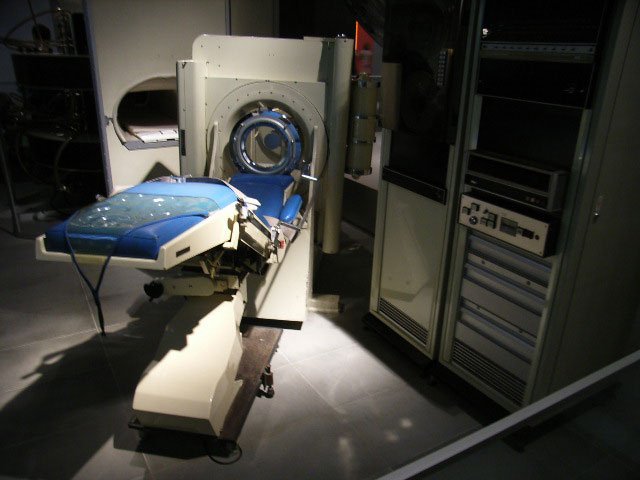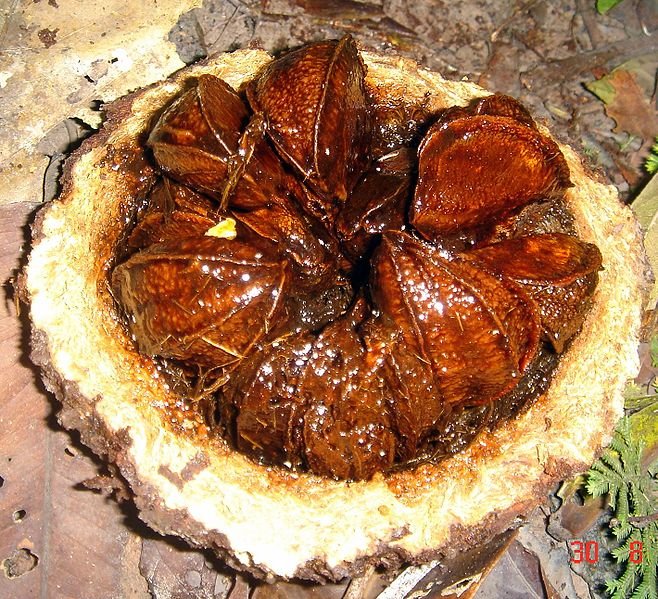Updated: December 9, 2016
Here's an interesting thought slash question. Bananas are slightly radioactive. Fact. This is because they contain Potassium. Good. Now, when you eat bananas, you introduce radioactive isotopes into your body. A tiny tiny amount that makes no difference against the likes of the background radiation and bad genes. But.
What would be the needed mass of bananas so they generated a lethal dose (LD50) to kill a human standing in their vicinity? Is this even doable? Well, let us embark on a quest of unraveling this highly critical [sic] and completely useless mystery. After me, banana lovers.

Like a nuclear reactor, only better.
Note: Image taken from Wikipedia, licensed under CC BY-SA 3.0.
Banana Equivalent Dose (BED)
As it turns out, this is not a new concept. There's even a Wikipedia entry [1] on this topic, which serves as a good baseline for our pointless article. So let's discuss the mechanics of the whole thing first. Quoting from the Wiki article:
According to the US Environmental Protection Agency (EPA), isotopically pure potassium-40 will give a committed dose equivalent of 5.02 nanosieverts over 50 years per becquerel ingested by an average adult. Using this factor, one banana equivalent dose comes out as about 5.02 nSv/Bq × 31 Bq/g × 0.5 g ? 78 nSv = 0.078 uSv. In informal publications, one often sees this estimate rounded up to 0.1 uSv.
For those of you wondering what Becquerel [2] might be, it is the unit of radioactivity - how many nucleus decays are occurring per second. The more the merrier. All right, a typical banana will contain a very small amount of Potassium, some of which will be radioactive, hence the estimated dose of 0.1 uSv.
Is that a lot?
No, it is not. Just by living on Planet Earth, depending on where you are, the composition of the mantle under your feet, whether you live in a valley or high a place (like say Denver, Colorado, USA), a basement apartment - cellars and underground rooms and facilities normally have elevated levels of Radon - or a tall building, medical history, smoking, proximity to industry and traffic, other environmental hazards and delights, you will typically be exposed to 2-3 mSv per year [3]. If you like in France, Finland or Chernobyl, Ukraine, you will enjoy slightly more than this value.
This translates to roughly 25,000 bananas, which, if you ate at regularly spaced intervals throughout the year amounts to one hell of a constipation. You would need to eat 70 bananas per day. With the average weight of about 100 grams, and 89 kcal per 100 gram nutritional value, this amount of yellow food would provide you with roughly 6,500 kcal of energy, roughly three times more than an average adult need. Constipation would only be one of your problems. You would also get fat quickly - or spend a lot of time doing sports, which again, can be tricky, if you're permanently constipated.

If we all had this kind of entertainment while a-loo-ing, we would never need smartphones! Just kidding, if you use a phone while in/on the toilet, you need to get your hands chopped off with a lightsaber.
As we can see, the risk of banana health hazard comes purely from a significant mass of ingested fiber rather than radioactivity. For that matter, any food consumed in very large quantities is likely to kill just by brute force rather than any long-term damage of whatever it may contain.
Last but not the least, the effects of radiation from bananas is not cumulative, because the human body has a very delicate and efficient mechanism of regulating its Potassium levels. You will simply flush it out, provided you are not constipated. We go back to the original problem of eating bananas en masse.
So what do we need for LD50?
All right. Going back to the banana problem, the lethal dose for an average human is roughly 5 Sv. This translates into about 50 million bananas. Eating that many is definitely not feasible. But what if we placed these 50 million bananas in the vicinity of a human? What then? Could we somehow assemble an array of bananas in such a way that their radioactive decays is focused into a single, human-shaped target?
We need to study the properties of Potassium-40 [4] a little more. Radiation comes in several flavors. Alpha particles are easily shielded using nothing more than a piece of paper. Beta particles can penetrate your skin, but they usually won't do much more than that. Gamma rays can hit inside your body and cause random changes to your cells. Looking at the medical industry, radiation from isotopes with the spectrum in the range of 40-60 keV will normally be absorbed in your body. In the range of 80-120 keV, you will get some absorption, but most of the particles will go through, partially attenuated. This mechanism is used in CT scanners. The thickness and density of your various organs will result in a change in the energy spectrum emitted by the scanner and received by the detector array on the opposite side. Repeated multiple times while the CT is rotating round your body, with the right reconstruction algorithms, it is possible to create a color-based 3D slice-image of the patient.

Airport scanner usually have higher energies - roughly 140 keV [5], which normally bounce off the body rather than get absorbed. This is good for you, and also for security agencies, which need the backscatter to decide what kind of naughty stuff you might be wearing under your clothes.
Now, Potassium. About 90% of its radioactivity comes in the form of Beta particles, with the maximum energy of about 1.3 MeV, and 10% gamma ray with the energy of 1.46 MeV. The risk from these, even when ingested, is quite small. Based on the study by Argonne National Laboratory [6], a lifetime cancer mortality risk from soil exposure to Potassium-40 is only about 4 in 100,000, compared to roughly 20,000 out of 100,000 for all other causes of cancer. Ingestion poses an even lower risk, and not all of the released energy reacts with your cells, especially since the decay particles are quite energetic. The best analogy is a rifle bullet. If it hits your body with a sufficiently fast velocity, it is more likely to exit without fragmenting rather than getting lodged inside your tissues.
Let's model it
All right. So what we need is a theoretical model where all the energy emitted from a banana would be narrowly vectored into a human target, and we can expect all of that energy to be absorbed in the body. This means we need some kind of a hollow sphere, with the human inside it. The sphere would be enclosed, so that the radiation bounces back into the sphere. If we take into account the fact some of the bananas would act as a shield, plus the distance from the human body, we would need to increase the amount of fruit by at least an order of magnitude or more. Then, we get into a problem of even more distance and bananas shielding the target from intended radiation. It's just not feasible.
But for the sake of argument, 500 million bananas would be required. With the average weight of 100 grams, this translates into 50 million kg, or 50,000 tons of pulp. Bananas have a density roughly half that of water [7], so we're talking about 25,000 tons of water. Technically, we need a small tanker. Sphere wise, we need one with a radius of about 18 meters [8] - or 19 meters, so we can leave a tiny space for the human in the very center.
Well, the thing is - this is just banana solids. Bananas also contain water, and they are not the most spatially efficient fruit, so actually stacking bananas as they are would take more space and volume. We would also need some kind of a supporting structure to keep them in place and prevent them from getting squashed. Without these safeguards, the human patient would drown in banana split. Oh, that's so witty!

The Attack of the Bananas, Episode VII.
Note: Image taken from Wikipedia, licensed under CC BY-SA 2.5.
Can we do better?
Unlikely. Bananas are not the most radioactive food out there. Brazil nuts are, in essence, more radioactive than bananas [9]. While our yellow fruit - or technically a berry - contains 3,520 pCi/kg of 40K, Brazil nuts deliver about 5,600 pCi/kg of 40K but also 1,000-7,000 pCi/kg of 226Ra. Moreover, the nuts also have a somewhat higher density than bananas, roughly 579 kg/m3 rather than 422 kg/m3. However, the radioactivity model is more interesting. The decay is mostly Alpha particles, with the energy of 4.8 MeV. If they get ingested, it could be quite tricky, but because alpha particles are very heavy, they are easily stopped, even with a simple sheet of paper, their energy notwithstanding. So the sphere of Brazil nuts, slightly smaller than the one before, would be an interesting place to find yourself in, but just wearing clothes would be enough to negate any radioactivity. In fact, most of the radiation would be blocked by the nuts themselves, layer after layer.

This is not an alien embryo hatching, these are Brazil nuts. Dem nuts.
Note: Image taken from Wikipedia, licensed under CC BY-SA 4.0.
Eventually, it all comes down to nutrition. Brazil nuts pose all sorts of health risks if consumed in large quantities. The presence of aflatoxins in their shells and the larger-than-life concentrations of Selenium - just 5 grams of nuts contains the daily value for the average human - means you would never quite face the constipation challenge like your typical banana lover.
Conclusion
There you go, fellas. We tried to build some kind of a perverted banana-made nuclear reactor slash something, and we failed. There's a reason why bananas are not used as a fuel, and for a good reason. They just don't have enough radioactivity to generate sufficient heat that can be nicely converted into electricity. The energy density from decays is way too low. The hazards all come from constipation.
Think about it. There's a reason why banana is a FOOD. Because we can eat it without dying. And that means it's not designed to be assembled into power-generating devices. Well, maybe one day. I hope you find this stupid little article entertaining. Take care, and watch your diet. And share the word.
References
You seem to ask for these, so here:
[1] https://en.wikipedia.org/wiki/Banana_equivalent_dose
[2] https://en.wikipedia.org/wiki/Becquerel
[3] https://www.gov.uk/government/publications/ionising-radiation-dose-comparisons/
ionising-radiation-dose-comparisons
[4] https://en.wikipedia.org/wiki/Potassium-40
[5] http://www.aber.ac.uk/temp-ancient-tl/issue21_1/haustein_atl_21(1)_7-10.pdf
[6] http://phi.nmsu.edu/~pvs/teaching/phys593/potassium.pdf
[7] http://www.aqua-calc.com/page/density-table/substance/
bananas-coma-and-blank-dehydrated-coma-and-blank-or-blank-banana-blank-powder
[8] https://www.wolframalpha.com/input/?i=radius+of+a+sphere+with+a+volume+of+25000000+liters
[9] http://www.physics.isu.edu/radinf/natural.htm
Cheers.